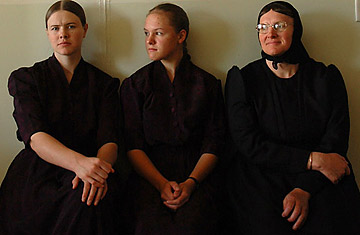
Silent Light
Carlos Reygadas' name is rarely mentioned as part of the recent surge of Mexican cinema. The directors usually cited are the three amigos Alfonso Cuaron (Y tu mamá también, Harry Potter and the Prisoner of Azkaban), Alejandro Gonzalez Inarritu (Amores perros, Babel) and Guillermo Del Toro (Pan's Labyrinth, Hellboy). Yet Reygadas, 37, has made the biggest noise at international film festivals and among the more intellectual critics. His Japon and Battle in Heaven won praise for their filmmaking rigor, caustic view of Mexico's social ills and often frank take on sex.
With Stellet Licht (Silent Light), which won the Jury Prize at Cannes in 2007 and opened Jan. 7 at New York City's Film Forum, Reygadas shocks again: this drama of a Mennonite community in northern Mexico contains no explicit hanky-panky. In its way, the film is true to the severe, austere code of the Mennonites. Yet it is shot with such care and creativity that each scene has a visual, emotional luster. One critic jokingly called Silent Light the best film ever made in its language — an easy claim to fame, since it is probably the only film in which the characters speak Plautdietsch, the form of Low German used by the sect in Europe, Latin America and Canada. One could make a grander claim: that this is among the finest recent foreign films. And to viewers conditioned to the speed and swagger of Hollywood product, one of the most foreign. (See TIME's list of the top 10 films of 2008.)
Reygadas sets Silent Light's agenda in the first moments. The film opens with a nearly five-minute time-lapse shot of night sky, stars, dawn slowly breaking and finally full daylight, as the sound track comes alive with loud crickets, braying and mooing, and breathy, muffled screams. Brilliant sunshine bathes the kitchen of a Mennonite farm as the family takes morning prayer in a silence broken only by the loud ticking of a clock. Esther (Miriam Toews), the mother, raises her eyes; Johan (Cornelio Wall Fehr), the father, says, "Amen"; and the children dive wordlessly into their cereal. After the meal, Esther leaves to shepherd the kids on errands, returning briefly to tell Johan to take some time for himself this morning. Alone, he weeps inconsolably.
Johan — father of six, devoted husband, devout believer — has fallen in love with another upright Mennonite, Marianne (Maria Pankratz). Can he end the affair? If not, what will the repercussions be for his family, his community, his beliefs?
Reygadas dramatizes this with small, telling gestures in long-take shots of the countryside, using the wide screen to place the land's natural beauty against the internal conflicts of the three main participants. The director also constructs elaborate pairs of sequences, one toward the beginning of Silent Light, the other toward the end. The opening dawn is the prelude to the closing dusk (which consumes the film's last five minutes); a church service precedes a wake; a passionate kiss of love is followed by the restorative kiss of life.
All this is not merely attention to visual and behavioral detail; it is a consummate film artist's conjuring of a world and its inhabitants. Reygadas elicits strong performances from his amateur cast of Mennonites, whose cowboy hats, plain speaking and ease in inhabiting their sagebrush environment give them the stature of western-movie archetypes. They support the filmmaker's genius for sanctifying each moment: the milking of cows and harvesting of grain, the children being washed in a stream, a rush through a cornfield for a sweetly illicit tryst, the sobbing of a woman in the forest in the rain. When melodrama intrudes, it has the power of inevitable tragedy — and then of redemption.
The style that predominates in current high-art festival films — films that rarely get much exposure in U.S. movie houses — is minimalist. Springing from the works of great directors like Carl-Theodor Dreyer and Robert Bresson, minimalism follows certain rules, as restrictive as Mennonite edicts. Pare down movie technique to its essentials; show characters behaving, however mutely, rather than acting; make viewers work for their epiphanies. This style has been responsible for many small, lugubrious films and — from directors who know how to make more of less — a few masterpieces. Silent Light is one of them.
